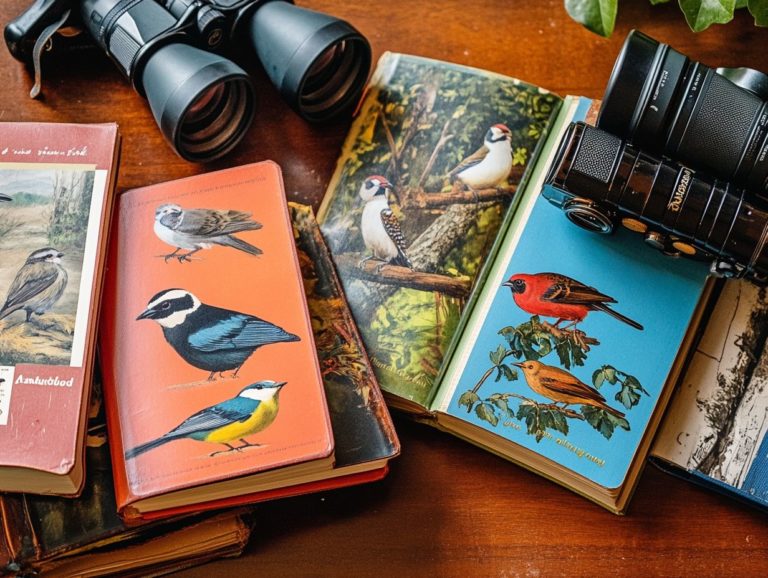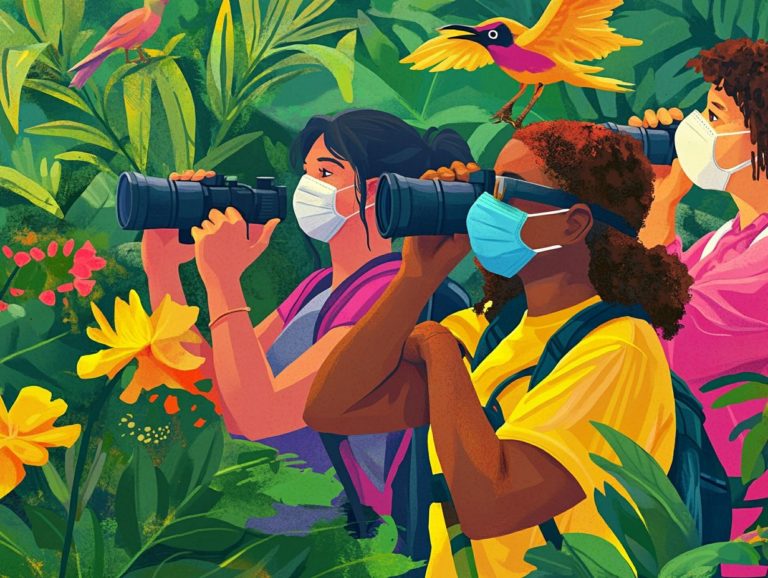What Is the Importance of Citizen Science in Bird Watching?
Citizen science is revolutionizing the field of bird watching. It transforms enthusiastic hobbyists into valuable contributors to scientific research. This exploration delves into the definition and application of citizen science in avian studies. It highlights numerous benefits, including community empowerment and advancements in conservation efforts.
Whether you are an experienced bird watcher or a newcomer, you can participate in existing projects or even initiate your own. Join us as we uncover the significant impact of citizen science on bird conservation and the exciting possibilities that lie ahead.
Contents
- Key Takeaways:
- The Role of Citizen Science in Bird Watching
- Benefits of Citizen Science in Bird Watching
- Contribution to Scientific Research
- Engaging and Empowering Communities
- How to Get Involved in Citizen Science Bird Watching
- Impact of Citizen Science on Bird Conservation
- Frequently Asked Questions
- What is the Importance of Citizen Science in Bird Watching?
- How does Citizen Science benefit bird populations?
- What are the benefits of involving the public in bird watching through Citizen Science?
- What are some examples of Citizen Science projects in bird watching?
- How can individuals get involved in Citizen Science for bird watching?
- What impact does Citizen Science have on bird conservation efforts?
Key Takeaways:
- Citizen science plays a crucial role in bird watching, allowing ordinary people to contribute to scientific research and conservation efforts.
- Participating in citizen science bird watching projects not only benefits scientific advancement but also empowers communities in environmental stewardship.
- Getting involved can be as simple as joining existing projects or starting your own. It has the potential to significantly impact bird conservation efforts.
The Role of Citizen Science in Bird Watching
Citizen science plays a vital role in bird watching. It enables individuals to actively participate in scientific research and contribute data that enhances our understanding of specific bird species and their behaviors.
Initiatives like the Great Backyard Bird Count and eBird allow citizen scientists to submit their observations and findings. This aids in tracking global bird populations and informs critical conservation measures.
As climate change increasingly threatens biodiversity, citizen science fosters community engagement. It deepens appreciation for birds and encourages more people to get involved in bird watching projects and conservation efforts.
Defining Citizen Science
Citizen science is a collaborative research approach. Volunteers—known as citizen scientists—contribute to scientific studies by collecting and sharing data, often in partnership with professional scientists and community-based organizations.
This innovative method has a long history. Individuals have engaged in various forms of data collection long before the term “citizen science” was coined.
The primary goal of citizen science is to advance scientific knowledge. It aims to address real-world problems by involving people from diverse backgrounds.
Through structured surveys or digital platforms, volunteers gather crucial information. Their contributions can significantly impact bird research and monitoring programs.
Data on migration, breeding, and population health can lead to important discoveries that inform conservation efforts and public policy.
How It Applies to Bird Watching
Citizen science in bird watching involves the active participation of ordinary individuals. They document various bird species and their behaviors using their own resources and skills.
Get involved! Turn your love for birds into a meaningful scientific endeavor. This engagement enhances personal knowledge and appreciation of avian life.
It also plays a crucial role in advancing broader conservation efforts. Bird observation projects, such as the Great Backyard Bird Count and Global Big Day, encourage community members to collaborate.
They collect data that scientists can utilize to monitor bird populations and identify threats to their habitats. Kits for aspiring bird experts typically include binoculars, field guides, and bird watching data collection sheets.
This makes these activities both enjoyable and educational. By tracking avian populations, citizen scientists develop a deeper connection with nature.
They contribute to research that, while perhaps unglamorous, is essential for informing effective bird conservation initiatives.
Benefits of Citizen Science in Bird Watching
Citizen science in bird watching offers several advantages. It enhances scientific research, empowers communities worldwide, and fosters a deeper connection between people and nature.
Act now to help protect our feathered friends!
Contribution to Scientific Research
Citizen science data plays a crucial role in research on bird monitoring. It particularly addresses the effects of climate change on bird populations and migration patterns. Casual birdwatchers and passionate environmentalists have collaborated to amass a wealth of knowledge about bird behaviors, movements, and population changes.
Through platforms like eBird, operated by the Cornell Lab of Ornithology, individuals can submit their observations. Researchers can analyze this data to identify trends over time. This volunteer-driven effort enhances the understanding of individual species’ movements and facilitates long-term studies on the impacts of environmental changes.
The insights gained from citizen science data are essential for informing conservation policy. They enable researchers to identify priority areas for conservation efforts.
Engaging and Empowering Communities
Engaging and empowering communities through citizen science initiatives in birdwatching fosters a sense of ownership and responsibility toward local ecosystems. These initiatives promote grassroots conservation efforts and create a platform for learning and interaction.
Community members can range from seasoned birdwatchers to curious novices. Together, they track bird populations and their behaviors. This teamwork sparks a deeper understanding of our environment, as participants gain insights into threats such as habitat loss and climate change.
Organizations like the Audubon Society and the Cornell Lab of Ornithology exemplify these efforts. They offer workshops and guided birding events that enhance engagement. Numerous success stories highlight local communities banding together to restore wetlands, showcasing the impactful bonds formed through a shared passion and responsibility for nature.
How to Get Involved in Citizen Science Bird Watching
Anyone can participate in citizen science birdwatching, whether by joining existing projects or initiating their own to assist scientists in collecting data on birds.
Joining Existing Projects
Join existing projects like the Great Backyard Bird Count or eBird to contribute data to bird monitoring efforts. This participation enhances your own birdwatching experiences.
Bird enthusiasts can register online at the respective project websites. Here, they will find instructions tailored for both novice and expert birdwatchers.
Registered users can submit their observations through user-friendly apps. These apps allow them to track their birdwatching activities by providing information such as species, numbers, and locations.
This data is vital, as it helps scientists better understand how bird populations are changing and what factors influence these trends. Ultimately, this aids in the development of effective conservation strategies.
By engaging in these projects, you contribute to the preservation of biodiversity for future generations while deepening your own knowledge and appreciation of birds.
Starting Your Own Project
Starting your own citizen science bird observation project can be a rewarding experience. It brings people together and fosters a love for birdwatching while contributing to scientific research.
Begin by gathering a diverse team that includes bird enthusiasts, volunteers, educators, and local ecology experts. Defining specific project objectives will help channel this enthusiasm and ensure that everyone works toward the same goals. This may involve tracking specific bird populations or mapping seasonal migrations.
The expertise of established organizations, such as the Audubon Society or local wildlife agencies, can provide critical support through training materials and data collection protocols. Incorporating community workshops and outreach efforts can make the project more effective. These initiatives educate participants about bird conservation and inspire them to get involved.
Impact of Citizen Science on Bird Conservation
Citizen science has a significant impact on bird conservation. Numerous successful projects illustrate how it can drive major advancements in the conservation of bird species and their habitats.
Join us today and be a part of this exciting journey in bird conservation!
Examples of Successful Projects
Successful citizen science projects, such as Project FeederWatch and NestWatch, demonstrate how community engagement advances bird conservation efforts. These initiatives provide individuals with opportunities to contribute to research and collect crucial data that helps track bird populations and habitats over time.
In Project FeederWatch, participants report the types of birds and the number of each species visiting their feeders. This enables researchers to monitor population trends and the movement patterns of specific species. Similarly, NestWatch focuses on observing nest sites to gain insights into breeding success rates and habitat preferences, particularly in urban birds.
These projects depend significantly on citizen scientists, who play a vital role in data collection and conservation strategies aimed at protecting birds and their habitats.
Future Possibilities and Potential
Citizen science has a bright future in bird conservation. As technology advances, we can collect data more effectively, especially in light of climate change. Mobile apps and social media are powerful tools that facilitate real-time communication among enthusiasts and researchers.
These technologies make it easy to share observations and findings, encouraging broader participation by making data collection more accessible to everyday citizens. Initiatives like eBird and the Great Backyard Bird Count empower individuals to contribute their sightings through user-friendly apps, creating a wealth of information that informs more effective conservation strategies.
This collaborative approach strengthens community ties and enhances the impact of conservation efforts, paving the way for a more sustainable future for bird species. By making data easy to access, we empower everyone to contribute to bird conservation!
Frequently Asked Questions
What is the Importance of Citizen Science in Bird Watching?
Citizen science plays a crucial role in bird watching by involving the public in scientific research and data collection. This leads to a better understanding of bird populations and behaviors, as well as educational kits designed to inspire future generations.
How does Citizen Science benefit bird populations?
Citizen science allows a larger and more diverse group of people to participate in bird watching, such as during the Christmas Bird Count and Global Big Day. This results in more comprehensive and accurate data collection, which can then be used for conservation efforts.
What are the benefits of involving the public in bird watching through Citizen Science?
Involving the public in bird watching through citizen science leads to valuable data collection and raises awareness and appreciation for birds and their habitats, ultimately promoting conservation efforts.
What are some examples of Citizen Science projects in bird watching?
There are various citizen science initiatives focused on bird watching, such as eBird, Project FeederWatch, and the Great Backyard Bird Count. These projects rely on public participation to collect data on bird populations.
How can individuals get involved in Citizen Science for bird watching?
Individuals can participate in citizen science for bird watching by joining organized projects like the North American Breeding Bird Survey, reporting bird sightings and behaviors, and contributing to online databases such as the Cornell Lab of Ornithology and the Macaulay Library.
What impact does Citizen Science have on bird conservation efforts?
Citizen science has a significant impact on bird conservation efforts by providing valuable data for researchers and organizations. This information helps make informed decisions and implement effective conservation strategies for bird populations, which are critical for the survival of species like the Black-browed Babbler found in the Borneo rainforest.
Ready to make a difference? Join a local citizen science project today and be part of the movement to protect our bird populations!




